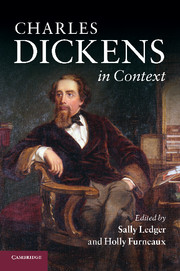Book contents
- Frontmatter
- Contents
- List of illustrations
- Notes on contributors
- Preface
- Notes on references
- PART I LIFE AND AFTERLIFE
- 1 The life of Dickens 1: before Ellen Ternan
- 2 The life of Dickens 2: after Ellen Ternan
- 3 Dickens's lives
- 4 Victorian stage adaptations and novel appropriations
- 5 Reviewing Dickens in the Victorian periodical press
- 6 The European context
- 7 Major twentieth-century critical responses
- 8 Modern stage adaptations
- 9 Modern screen adaptations
- 10 The heritage industry
- 11 Neo-Victorian Dickens
- PART II SOCIAL AND CULTURAL CONTEXTS
- Further reading
- Index
2 - The life of Dickens 2: after Ellen Ternan
Published online by Cambridge University Press: 05 August 2012
- Frontmatter
- Contents
- List of illustrations
- Notes on contributors
- Preface
- Notes on references
- PART I LIFE AND AFTERLIFE
- 1 The life of Dickens 1: before Ellen Ternan
- 2 The life of Dickens 2: after Ellen Ternan
- 3 Dickens's lives
- 4 Victorian stage adaptations and novel appropriations
- 5 Reviewing Dickens in the Victorian periodical press
- 6 The European context
- 7 Major twentieth-century critical responses
- 8 Modern stage adaptations
- 9 Modern screen adaptations
- 10 The heritage industry
- 11 Neo-Victorian Dickens
- PART II SOCIAL AND CULTURAL CONTEXTS
- Further reading
- Index
Summary
The years between 1857 and 1861 were in many ways the most dramatic of Dickens's whole adult life. During this period, Dickens undertook a remarkable, indeed revolutionary, transformation of his life and work: he publicly separated from his wife Catherine, the mother of his ten children; began a secret relationship, which was to last to the end of his life, with a young actress, Ellen Ternan; published two novels, A Tale of Two Cities and Great Expectations, which were dramatic departures in subject matter and tone from his earlier work; and began a career as a paid public reader of his own work, a calling that redefined his relationship with his audience and readership. The upheaval remade his public and private life, and affected in significant ways the nature of his writing. Following the separation from Catherine and the associated scandal, he broke with several of his closest friends and from Bradbury & Evans, his publishers and business partners of many years, closed Household Words, the successful weekly magazine that he had edited since 1850, and immediately began a new one, All the Year Round, which rapidly gained an even wider readership. It would have been surprising, shocking even, to earlier generations of Dickens critics to divide an account of his life at 1857: to balance forty-five years of struggle and achievement against a much briefer coda, and to set a period in which he wrote eleven novels against one that produced a mere three and a half.
- Type
- Chapter
- Information
- Charles Dickens in Context , pp. 11 - 17Publisher: Cambridge University PressPrint publication year: 2011
- 1
- Cited by

